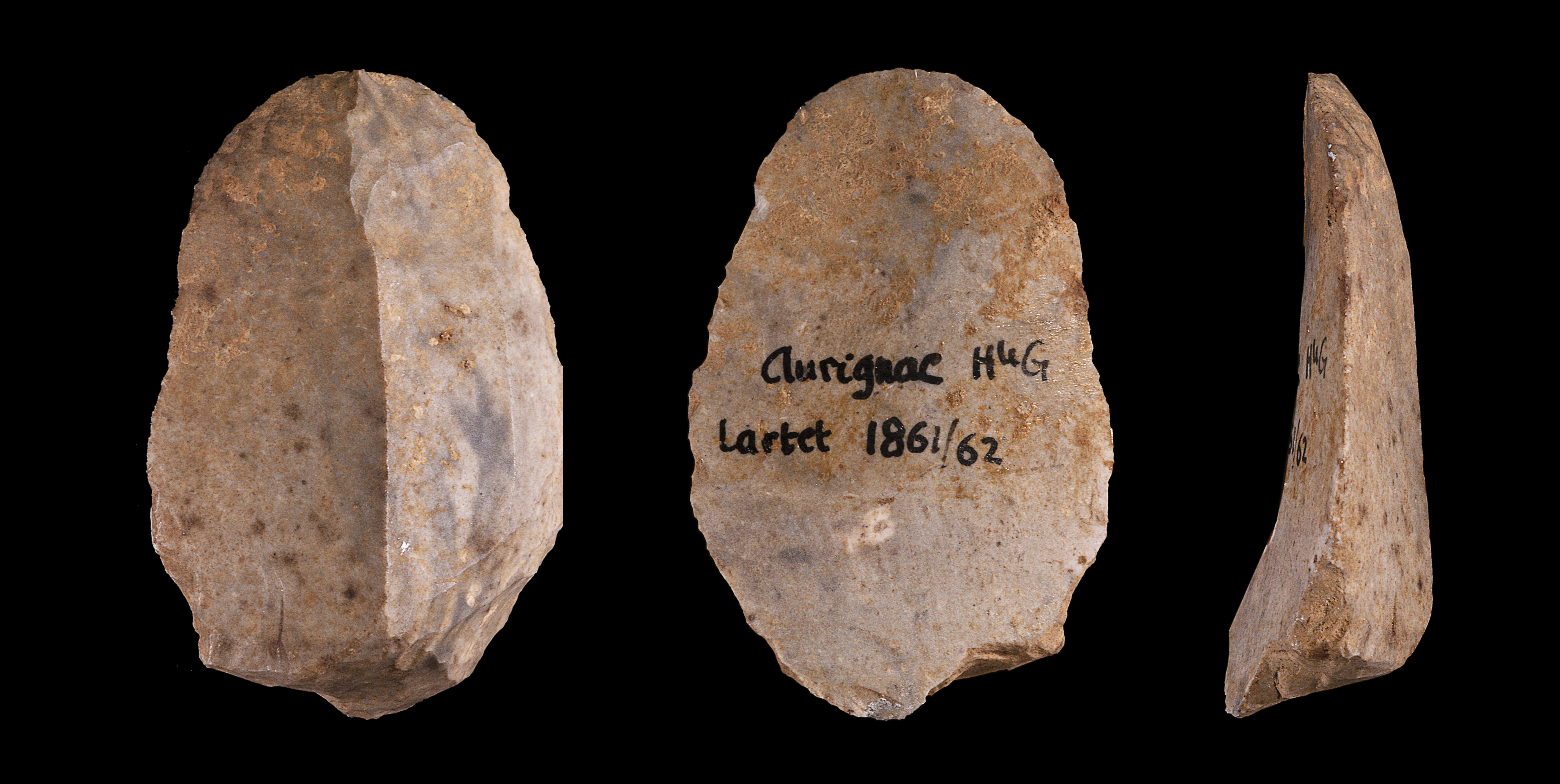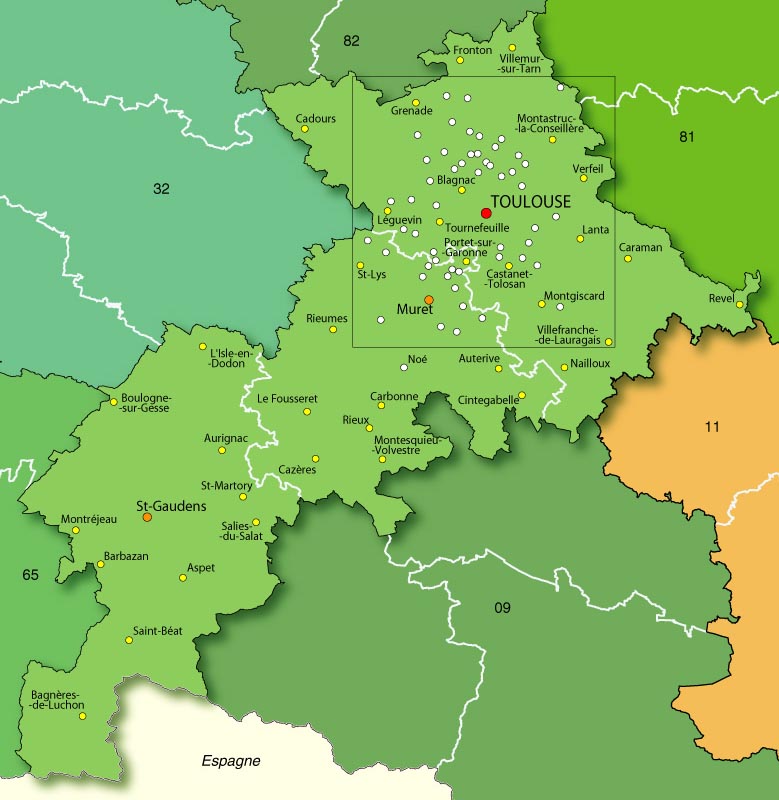|
Aurignac
Aurignac (; oc, Aurinhac) is a commune in the Haute-Garonne department in southwestern France, close to the Pyrénées. It was the seat of the former canton of Aurignac (population 4,160), which was composed of 19 communes. It is part of the ancient region known as the Comminges. Geography The town of Aurignac is located 60 km southwest of Toulouse and is, on average, 400m above sea level. It is in a regions of rolling hills close to the Pyrénées and is dominated by a ridge-shaped hill upon which the old town is built with the remains of a 13th-century castle at the top. History Aurignac is best known for the 1860 discovery, by Édouard Lartet, of prehistoric remains at the Cave of Aurignac, which led to the definition of the Aurignacian culture, an important phase in human prehistory. Evidence of early modern humans (often called Cro-Magnon man) has been found in Africa as far back as 160,000 years ago. When they came to Europe, about 45,000 years ago, their culture app ... [...More Info...] [...Related Items...] OR: [Wikipedia] [Google] [Baidu] |
Aurignacian
The Aurignacian () is an archaeological industry of the Upper Paleolithic associated with European early modern humans (EEMH) lasting from 43,000 to 26,000 years ago. The Upper Paleolithic developed in Europe some time after the Levant, where the Emiran period and the Ahmarian period form the first periods of the Upper Paleolithic, corresponding to the first stages of the expansion of ''Homo sapiens'' out of Africa. They then migrated to Europe and created the first European culture of modern humans, the Aurignacian. An Early Aurignacian or Proto-Aurignacian stage is dated between about 43,000 and 37,000 years ago. The Aurignacian proper lasts from about 37,000 to 33,000 years ago. A Late Aurignacian phase transitional with the Gravettian dates to about 33,000 to 26,000 years ago. The type site is the Cave of Aurignac, Haute-Garonne, south-west France. The main preceding period is the Mousterian of the ''Neanderthals''. One of the oldest examples of figurative art, the Venus ... [...More Info...] [...Related Items...] OR: [Wikipedia] [Google] [Baidu] |
Cro-Magnon
Early European modern humans (EEMH), or Cro-Magnons, were the first early modern humans (''Homo sapiens'') to settle in Europe, migrating from Western Asia, continuously occupying the continent possibly from as early as 56,800 years ago. They interacted and interbred with the indigenous Neanderthals (''H. neanderthalensis'') of Europe and Western Asia, who went extinct 40,000 to 35,000 years ago; and from 37,000 years ago onwards all EEMH descended from a single founder population which contributes ancestry to present-day Europeans. Early European modern humans (EEMH) produced Upper Palaeolithic cultures, the first major one being the Aurignacian, which was succeeded by the Gravettian by 30,000 years ago. The Gravettian split into the Epi-Gravettian in the east and Solutrean in the west, due to major climate degradation during the Last Glacial Maximum (LGM), peaking 21,000 years ago. As Europe warmed, the Solutrean evolved into the Magdalenian by 20,000 years ago, and these p ... [...More Info...] [...Related Items...] OR: [Wikipedia] [Google] [Baidu] |
Cave Of Aurignac
The Cave of Aurignac is an archaeological site in the commune of Aurignac, Haute-Garonne department in southwestern France. Sediment excavation and artefact documentation since 1860 confirm the idea of the arrival and permanent presence of European early modern humans during the Upper Palaeolithic. The eponymous location represents the type site of the Aurignacian, the earliest known culture attributed to modern humans in western Eurasia. Assemblages of Aurignacian tool making tradition can be found in the cultural sediments of numerous sites from around 45,000 years BP to around 26,000 years BP. In recognition of its significance for various scientific fields and the 19th-century pioneering work of Édouard Lartet the Cave of Aurignac was officially declared a national Historic Monument of France by order of May 26, 1921. Location The Aurignac limestone grotto is located in the Aurignac commune, approximately northwest of the town centre, on the southern side of the Rodes rivu ... [...More Info...] [...Related Items...] OR: [Wikipedia] [Google] [Baidu] |
Château D'Aurignac
The Château d'Aurignac is a ruined 13th century castle in the ''commune'' of Aurignac in the Haute-Garonne ''département'' of France. The castle was built on a hill before 1240 by Bernard V, Counts of Comminges, and the village developed around it. Henry IV ordered the destruction of the castle in the early 17th century and, although it was still partly inhabited in 1627, it fell into disuse not long afterwards. All that remains today are the church, a well-restored keep on the peak of the hill and some of the ramparts, which have been incorporated into houses. The property of the commune, it has been listed since 1979 as a ''monument historique'' by the French Ministry of Culture. See also *List of castles in France This is a list of castles in France, arranged by Region and Department. ;Notes: # The French word ''château'' has a wider meaning than the English ''castle'': it includes architectural entities that are properly called palaces, mansions or vine ... Referenc ... [...More Info...] [...Related Items...] OR: [Wikipedia] [Google] [Baidu] |
Édouard Lartet
Édouard Lartet (15 April 180128 January 1871) was a French geologist and paleontologist, and a pioneer of Paleolithic archaeology. Biography Lartet was born near Castelnau-Barbarens, ' of Gers, France, where his family had lived for more than five hundred years. He was educated for the law at Auch and Toulouse, but having private means elected to devote himself to science. The then recent work of Georges Cuvier on fossil Mammalia encouraged Lartet in excavations which led in 1834 to his first discovery of fossil remains in the neighborhood of Auch.G. Bibby, ''The Testimony of the Spade'' (Fontana 1962) p. 47 For the next decade and a half, he continued to explore the geography and palaeontology of the Pyrenees, uncovering ancestral apes close to the hominid line at Sansan, Gers, Sansan. In 1860, hearing of the discovery of human bones at a cave at Aurignac, and inspired by the work of William Pengelly, he turned his attention most fruitfully to the cave systems of the Dordogne ... [...More Info...] [...Related Items...] OR: [Wikipedia] [Google] [Baidu] |
Communes Of The Haute-Garonne Department
The following is a list of the 586 communes of the French department of Haute-Garonne. The communes cooperate in the following intercommunalities (as of 2020):BANATIC Périmètre des EPCI à fiscalité propre. Accessed 3 July 2020. * *CA * * [...More Info...] [...Related Items...] OR: [Wikipedia] [Google] [Baidu] |
Anatomically Modern Humans
Early modern human (EMH) or anatomically modern human (AMH) are terms used to distinguish ''Homo sapiens'' (the only extant Hominina species) that are anatomically consistent with the range of phenotypes seen in contemporary humans from extinct archaic human species. This distinction is useful especially for times and regions where anatomically modern and archaic humans co-existed, for example, in Paleolithic Europe. Among the oldest known remains of ''Homo sapiens'' are those found at the Omo-Kibish I archaeological site in south-western Ethiopia, dating to about 233,000 to 196,000 years ago, the Florisbad site in South Africa, dating to about 259,000 years ago, and the Jebel Irhoud site in Morocco, dated about 315,000 years ago. Extinct species of the genus ''Homo'' include ''Homo erectus'' (extant from roughly 2 to 0.1 million years ago) and a number of other species (by some authors considered subspecies of either ''H. sapiens'' or ''H. erectus''). The divergence of ... [...More Info...] [...Related Items...] OR: [Wikipedia] [Google] [Baidu] |
Communes Of Haute-Garonne
The following is a list of the 586 communes of the French department of Haute-Garonne. The communes cooperate in the following intercommunalities (as of 2020):BANATIC Périmètre des EPCI à fiscalité propre. Accessed 3 July 2020. * *CA * * [...More Info...] [...Related Items...] OR: [Wikipedia] [Google] [Baidu] |
Toulouse
Toulouse ( , ; oc, Tolosa ) is the prefecture of the French department of Haute-Garonne and of the larger region of Occitania. The city is on the banks of the River Garonne, from the Mediterranean Sea, from the Atlantic Ocean and from Paris. It is the fourth-largest city in France after Paris, Marseille and Lyon, with 493,465 inhabitants within its municipal boundaries (2019 census); its metropolitan area has a population of 1,454,158 inhabitants (2019 census). Toulouse is the central city of one of the 20 French Métropoles, with one of the three strongest demographic growth (2013-2019). Toulouse is the centre of the European aerospace industry, with the headquarters of Airbus, the SPOT satellite system, ATR and the Aerospace Valley. It hosts the CNES's Toulouse Space Centre (CST) which is the largest national space centre in Europe, but also, on the military side, the newly created NATO space centre of excellence and the French Space Command and Space Academy. Thales ... [...More Info...] [...Related Items...] OR: [Wikipedia] [Google] [Baidu] |
Departments Of France
In the administrative divisions of France, the department (french: département, ) is one of the three levels of government under the national level ("territorial collectivities"), between the administrative regions and the communes. Ninety-six departments are in metropolitan France, and five are overseas departments, which are also classified as overseas regions. Departments are further subdivided into 332 arrondissements, and these are divided into cantons. The last two levels of government have no autonomy; they are the basis of local organisation of police, fire departments and, sometimes, administration of elections. Each department is administered by an elected body called a departmental council ( ing. lur.. From 1800 to April 2015, these were called general councils ( ing. lur.. Each council has a president. Their main areas of responsibility include the management of a number of social and welfare allowances, of junior high school () buildings and technical staff, ... [...More Info...] [...Related Items...] OR: [Wikipedia] [Google] [Baidu] |
Haute-Garonne
Haute-Garonne (; oc, Nauta Garona, ; en, Upper Garonne) is a department in the Occitanie region of Southwestern France. Named after the river Garonne, which flows through the department. Its prefecture and main city is Toulouse, the country's fourth-largest. In 2019, it had a population of 1,400,039.Populations légales 2019: 31 Haute-Garonne INSEE History Haute-Garonne is one of the original 83 departments created during the on 4 March 1790. It was created from part of the former provinces of an ...[...More Info...] [...Related Items...] OR: [Wikipedia] [Google] [Baidu] |
Bagnères-de-Luchon
Bagnères-de-Luchon (; oc, Banhèras de Luishon), also referred to as just Luchon, is a commune and spa town in the Haute-Garonne department in the Occitanie region of south-western France. The inhabitants of the commune are known as ''Luchonnais'' or ''Luchonnaises''. The commune has been awarded three flowers by the ''National Council of Towns and Villages in Bloom'' in the ''Competition of cities and villages in Bloom''. Geography Bagnères-de-Luchon is located on the Spanish border some 50 km south-west of Saint-Gaudens and 40 km south of Montréjeau at the end of a branch line of the Southern railway at the foot of the central Pyrenees. To the south the Luchonnais Mountains form a natural barrier and there is no crossing point into Spain. Access to the commune is by the D125 road from Salles-et-Pratviel in the north which passes through the town and continues south through the commune to its termination in the mountains. The D618A branches off the D125 south of ... [...More Info...] [...Related Items...] OR: [Wikipedia] [Google] [Baidu] |

.jpg)




